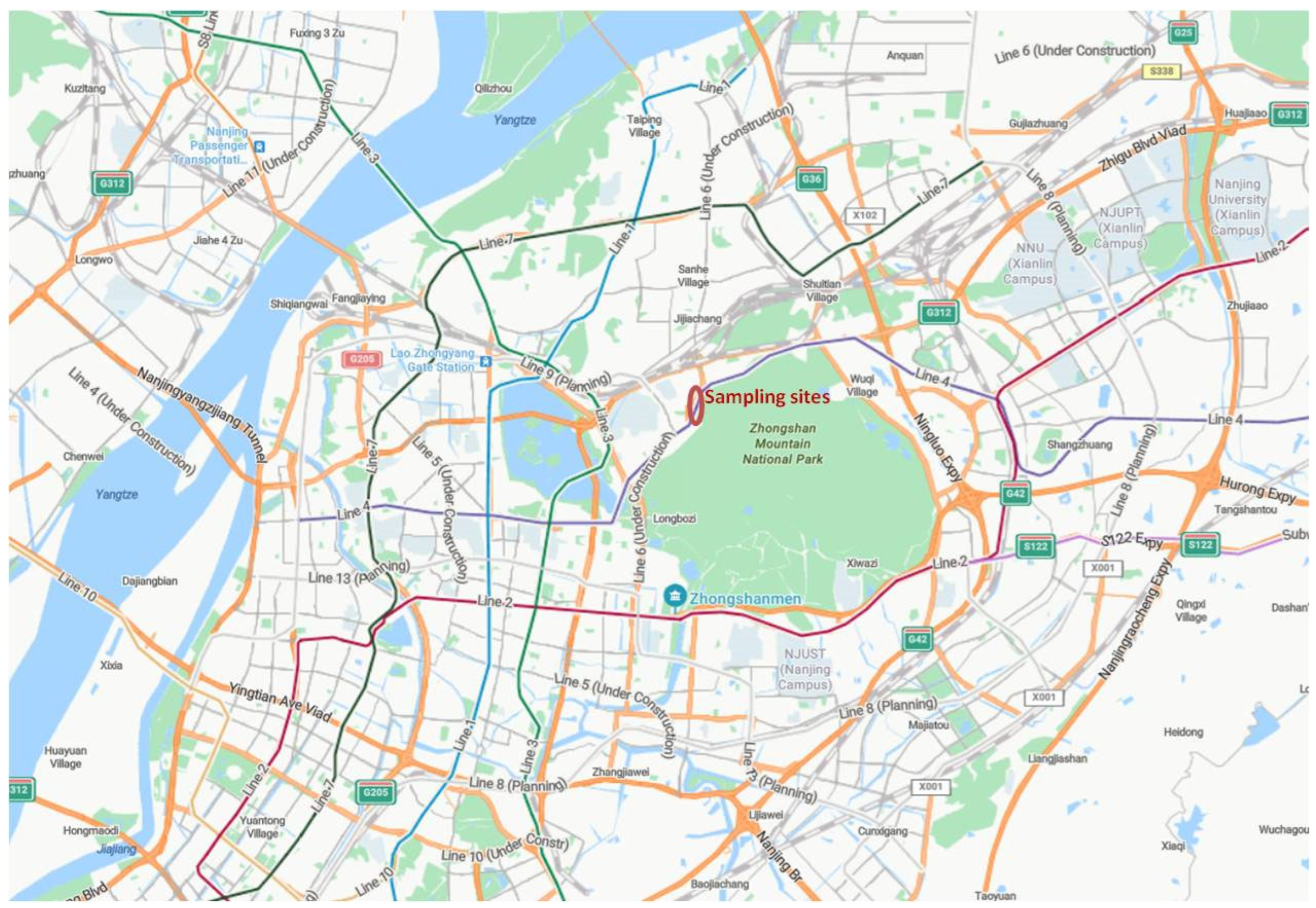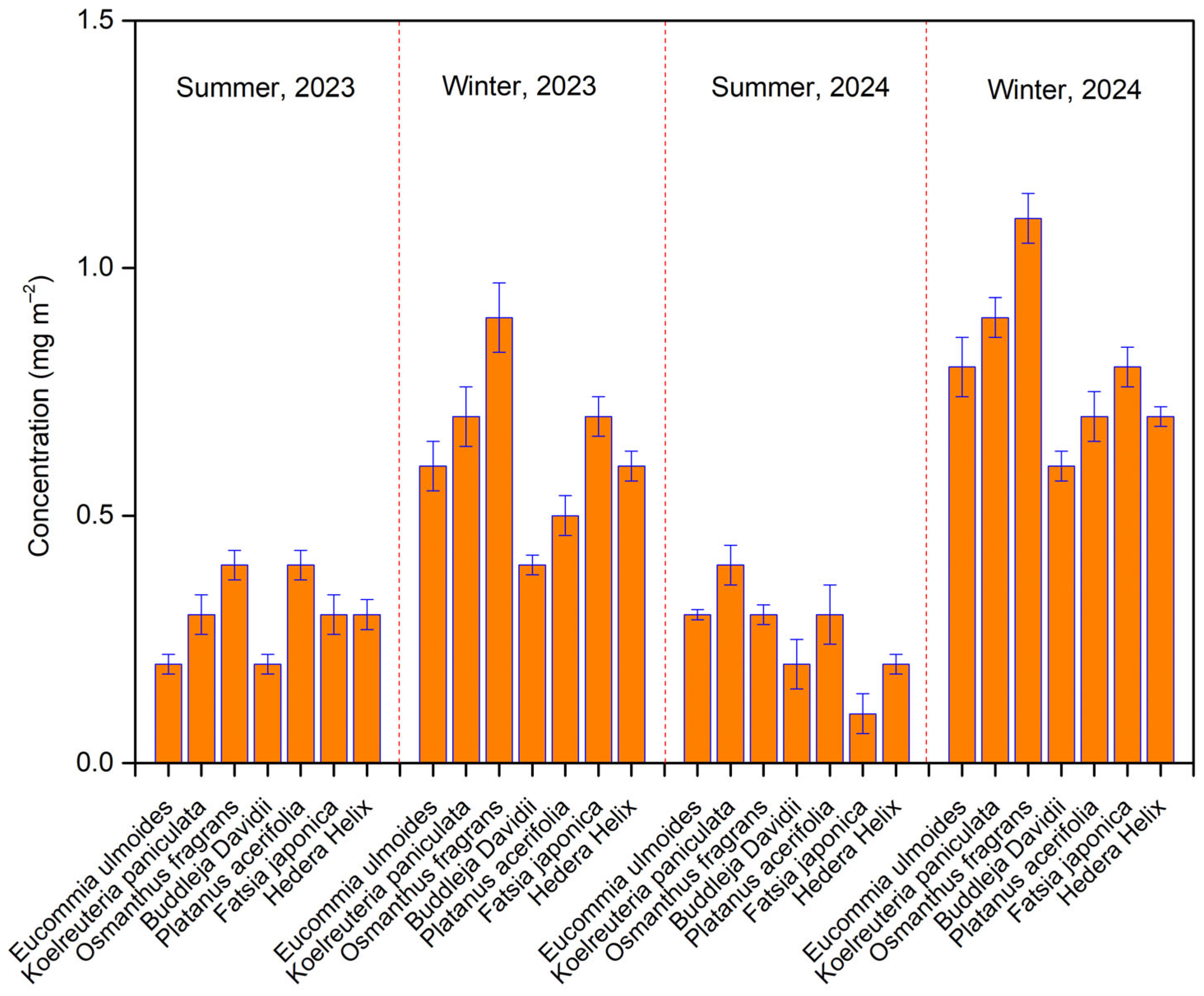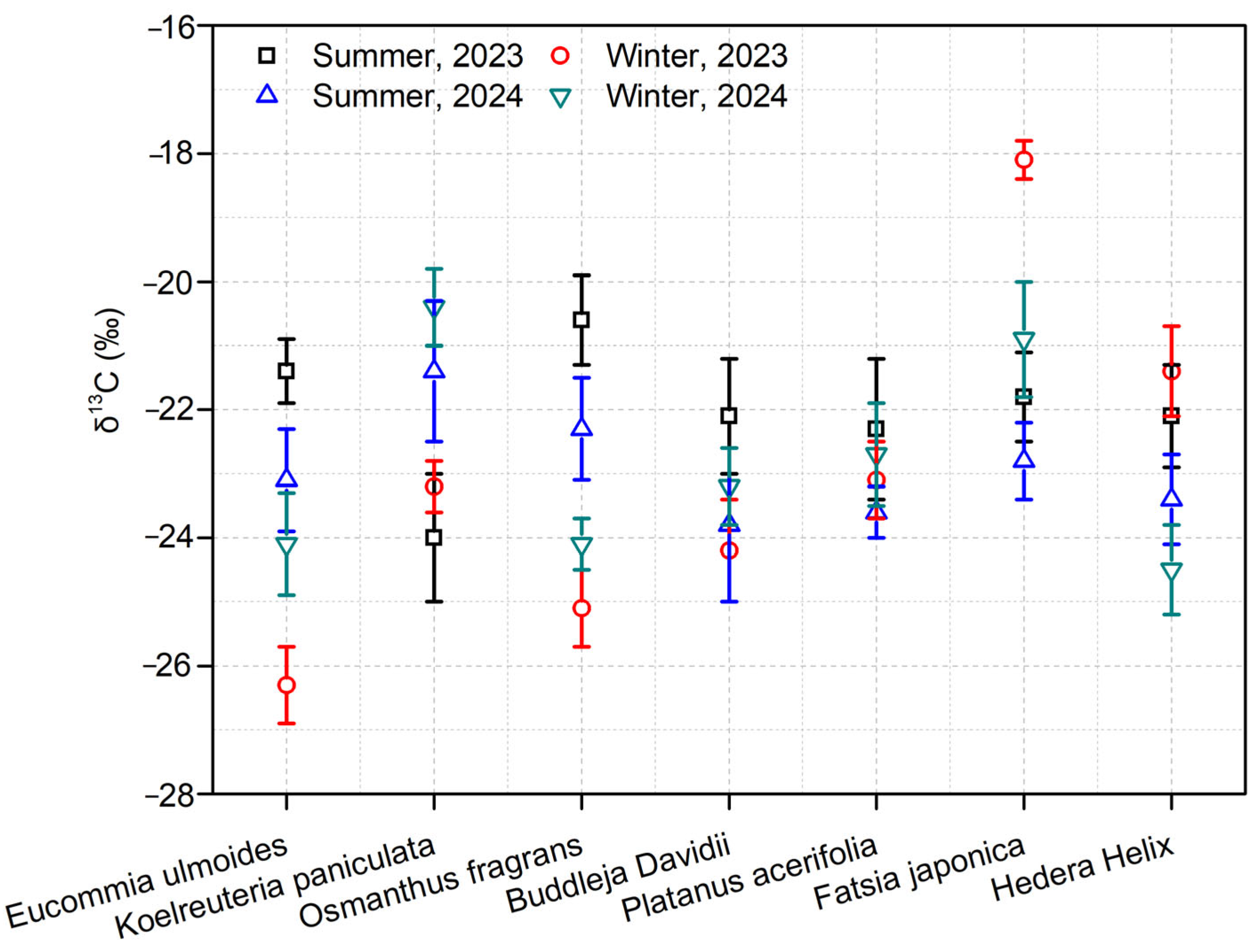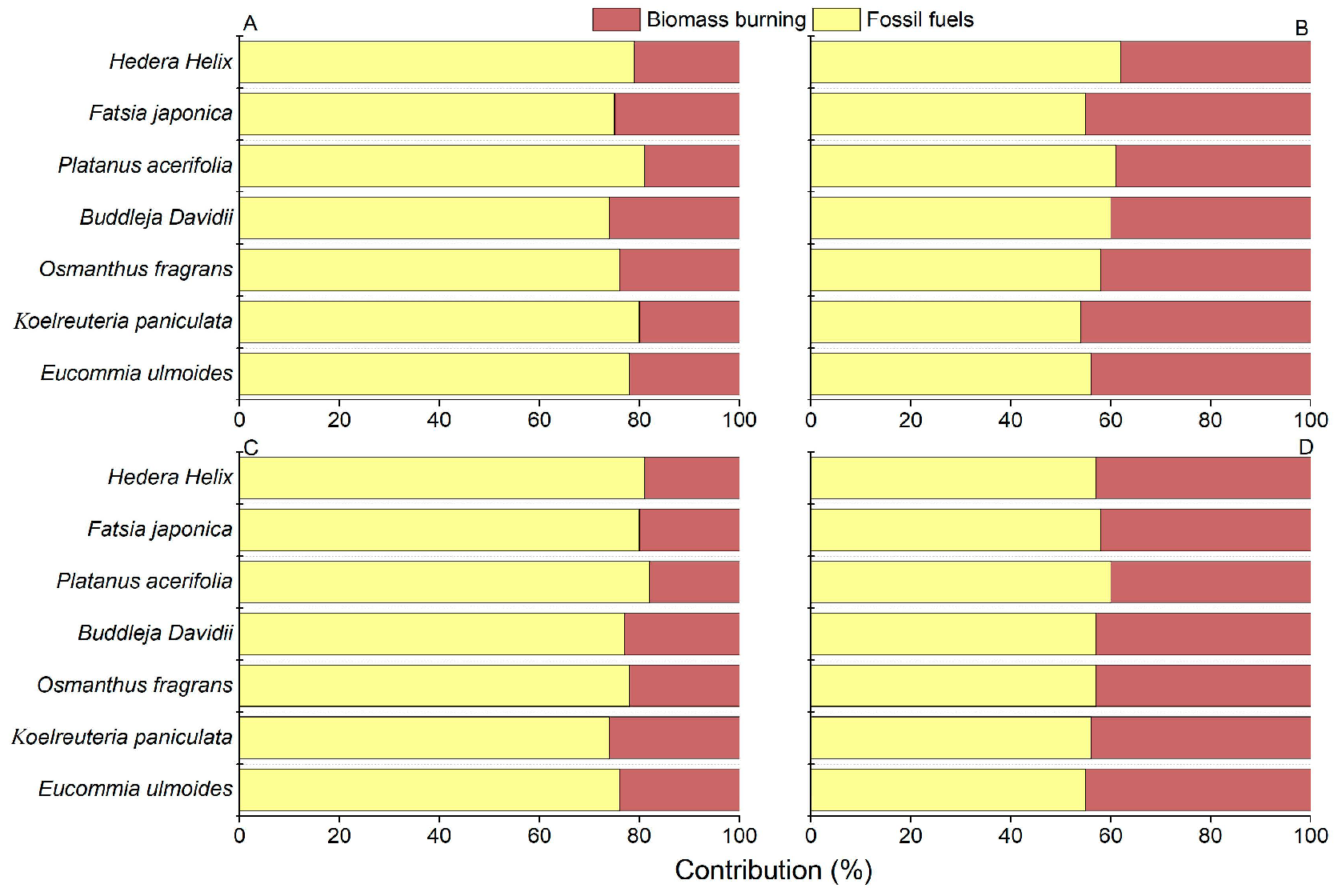Sources of the Deposition of Submicron Soot Particles on Plant Leaves
Simple Summary
Abstract
1. Introduction
2. Materials and Methods
2.1. Sample Collection
2.2. Sample Pretreatment
2.3. Soot Measurements
2.4. Stable Carbon Isotopes
2.5. Isotope Mass Balance Model
2.6. Statistical Analysis
3. Results and Discussion
3.1. Impacts of Carbonate Interference
3.2. Levels of Soot Across Species
3.3. Sources of Soot
4. Conclusions
Supplementary Materials
Funding
Institutional Review Board Statement
Informed Consent Statement
Data Availability Statement
Conflicts of Interest
References
- Chameides, W.L.; Bergin, M. Soot Takes Center Stage. Science 2002, 297, 2214–2215. [Google Scholar] [CrossRef]
- Moffet, R.C.; Prather, K.A. In-situ measurements of the mixing state and optical properties of soot with implications for radiative forcing estimates. Proc. Natl. Acad. Sci. USA 2009, 106, 11872–11877. [Google Scholar] [CrossRef]
- Rosenfeld, D.; Zhu, Y.; Wang, M.; Zheng, Y.; Goren, T.; Yu, S. Aerosol-driven droplet concentrations dominate coverage and water of oceanic low-level clouds. Science 2019, 363, eaav0566. [Google Scholar] [CrossRef] [PubMed]
- Andreae, M.O.; Ramanathan, V. Climate’s Dark Forcings. Science 2013, 340, 280–281. [Google Scholar] [CrossRef]
- Sun, X.; Hu, L.; Hu, B.; Sun, X.; Wu, X.; Bi, N.; Lin, T.; Guo, Z.; Yang, Z. Remarkable signals of the ancient Chinese civilization since the Early Bronze Age in the marine environment. Sci. Total Environ. 2022, 804, 150209. [Google Scholar] [CrossRef] [PubMed]
- Hansen, J.; Nazarenko, L. Soot climate forcing via snow and ice albedos. Proc. Natl. Acad. Sci. USA 2004, 101, 423–428. [Google Scholar] [CrossRef] [PubMed]
- Gili, J.; Maín, A.; van Drooge, B.L.; Viana, M. Source-resolved black carbon and PM2.5 exposures during wildfires and prescribed burns. Environ. Pollut. 2025, 368, 125660. [Google Scholar] [CrossRef]
- Thompson, S.A.; Aiken, A.C.; Huber, R.C.; Dubey, M.K.; Brooks, S.D. Detonation Soot: A New Class of Ice Nucleating Particle. J. Geophys. Res. Atmos. 2024, 129, 66. [Google Scholar] [CrossRef]
- Lill, E.; Costa, E.J.; Barry, K.; Mirrielees, J.A.; Mashkevich, M.; Wu, J.D.Y.; Holen, A.L.; Cesler-Maloney, M.; DeMott, P.J.; Perkins, R.; et al. The Abundance and Sources of Ice Nucleating Particles Within Alaskan Ice Fog. J. Geophys. Res. Atmos. 2024, 129, e2024JD041170. [Google Scholar] [CrossRef]
- Testa, B.; Durdina, L.; Edebeli, J.; Spirig, C.; Kanji, Z.A. Simulated contrail-processed aviation soot aerosols are poor ice-nucleating particles at cirrus temperatures. Atmos. Chem. Phys. 2024, 24, 10409–10424. [Google Scholar] [CrossRef]
- Adams, M.P.; Tarn, M.D.; Sanchez-Marroquin, A.; Porter, G.C.E.; O’Sullivan, D.; Harrison, A.D.; Cui, Z.; Vergara-Temprado, J.; Carotenuto, F.; Holden, M.A.; et al. A Major Combustion Aerosol Event Had a Negligible Impact on the Atmospheric Ice-Nucleating Particle Population. J. Geophys. Res. Atmos. 2020, 125, e2020JD032938. [Google Scholar] [CrossRef]
- Kärcher, B.; Kleine, J.; Sauer, D.; Voigt, C. Contrail Formation: Analysis of Sublimation Mechanisms. Geophys. Res. Lett. 2018, 45, 13547–13552. [Google Scholar] [CrossRef]
- Zhong, J.; Li, Y.H.; Bloss, W.J.; Harrison, R.M. Street-scale black carbon modelling over the West Midlands, United Kingdom: Sensitivity test of traffic emission factor adjustments. Environ. Int. 2025, 196, 109265. [Google Scholar] [CrossRef] [PubMed]
- Yang, Y.; Ma, M.H.; Zhou, L.; Wang, W.C.; Li, F.S. Study on the effect of soot generation from metal oxide/biodiesel nanofluid fuel combustion. Renew. Energy 2025, 243, 122498. [Google Scholar] [CrossRef]
- Zhang, Z.Q.; Li, D.M.; Niu, C.Y.; Pan, M.Z.; Guan, W.; Liu, H.; Lu, K.; Tan, D.L. Soot formation mechanism of modern automobile engines and methods of reducing soot emission for catalyzed diesel particulate filter: A review. Process Saf. Environ. Prot. 2024, 190, 1403–1430. [Google Scholar] [CrossRef]
- Michelsen, H.A.; Colket, M.B.; Bengtsson, P.E.; D’Anna, A.; Desgroux, P.; Haynes, B.S.; Miller, J.H.; Nathan, G.J.; Pitsch, H.; Wang, H. A Review of Terminology Used to Describe Soot Formation and Evolution under Combustion and Pyrolytic Conditions. ACS Nano 2020, 14, 12470–12490. [Google Scholar] [CrossRef]
- Liu, H.; Qi, L.J.; Liang, C.S.; Deng, F.Y.; Man, H.Y.; He, K.B. How aging process changes characteristics of vehicle emissions? A review. Crit. Rev. Environ. Sci. Technol. 2020, 50, 1796–1828. [Google Scholar] [CrossRef]
- Naidja, L.; Ali-Khodja, H.; Khardi, S. Sources and levels of particulate matter in North African and Sub-Saharan cities: A literature review. Environ. Sci. Pollut. Res. 2018, 25, 12303–12328. [Google Scholar] [CrossRef]
- Gao, Y.Q.; Ge, Y.H.; Ma, Y.F.; Zhao, H.L.; Xiao, G.X.; Show, P.L.; Chen, J.Q.; Guo, R.X.; Liu, Y.H. Occurrence, Migration, and Transformation of Black Carbon in Environmental Matrix and Its Influence on the Environmental Fate of Coexisting Pollutants: A Review. Rev. Environ. Contam. Toxicol. 2023, 261, 15. [Google Scholar] [CrossRef]
- Hu, Z.F.; Kang, S.C.; Li, C.L.; Zhang, C.; Yan, F.P.; Chen, P.F.; Danmuzhen, D. Fifty percent overestimation of black carbon concentration measured in aerosols of the Tibetan Plateau. Environ. Pollut. 2024, 363, 125277. [Google Scholar] [CrossRef]
- Wang, X.X.; Luo, X.; Zhang, Y.L.; Kang, S.C.; Chen, P.F.; Niu, H.W. Black carbon: A general review of its sources, analytical methods, and environmental effects in snow and ice in the Tibetan Plateau. Environ. Sci. Pollut. Res. 2024, 31, 3413–3424. [Google Scholar] [CrossRef] [PubMed]
- Maricq, M.M. Engine, aftertreatment, fuel quality and non-tailpipe achievements to lower gasoline vehicle PM emissions: Literature review and future prospects. Sci. Total Environ. 2023, 866, 161225. [Google Scholar] [CrossRef]
- Ramanathan, V.; Carmichael, G. Global and regional climate changes due to black carbon. Nat. Geosci. 2008, 1, 221–227. [Google Scholar] [CrossRef]
- Simoneit, B.R.T. Biomass burning—A review of organic tracers for smoke from incomplete combustion. Appl. Geochem. 2002, 17, 129–162. [Google Scholar] [CrossRef]
- Wang, R.; Tao, S.; Wang, W.T.; Liu, J.F.; Shen, H.Z.; Shen, G.F.; Wang, B.; Liu, X.P.; Li, W.; Huang, Y.; et al. Black Carbon Emissions in China from 1949 to 2050. Environ. Sci. Technol. 2012, 46, 7595–7603. [Google Scholar] [CrossRef] [PubMed]
- Li, B.G.; Gasser, T.; Ciais, P.; Piao, S.L.; Tao, S.; Balkanski, Y.; Hauglustaine, D.; Boisier, J.P.; Chen, Z.; Huang, M.T.; et al. The contribution of China’s emissions to global climate forcing. Nature 2016, 531, 357–361. [Google Scholar] [CrossRef]
- Tao, M.M.; Liu, Q.Y.; Schauer, J.J. Direct measurement of the deposition of submicron soot particles on leaves of Platanus acerifolia tree. Environ. Sci. Process. Impacts 2022, 24, 2336–2344. [Google Scholar] [CrossRef] [PubMed]
- Bird, M.I.; Ascough, P.L. Isotopes in pyrogenic carbon: A review. Org. Geochem. 2012, 42, 1529–1539. [Google Scholar] [CrossRef]
- Zhan, C.L.; Wan, D.J.; Zhang, J.Q.; Han, Y.M.; Cao, J.J.; Liu, X.L. Research progress on source apportionment methods of black carbon in the environment. Ecol. Environ. Sci. 2016, 25, 1575–1583. [Google Scholar]
- Suto, N.; Kawashima, H. Measurement report: Source characteristics of water-soluble organic carbon in PM2.5 at two sites in Japan, as assessed by long-term observation and stable carbon isotope ratio. Atmos. Chem. Phys. 2021, 21, 11815–11828. [Google Scholar] [CrossRef]
- Winiger, P.; Andersson, A.; Yttri, K.E.; Tunved, P.; Gustafsson, Ö. Isotope-Based Source Apportionment of EC Aerosol Particles during Winter High-Pollution Events at the Zeppelin Observatory, Svalbard. Environ. Sci. Technol. 2015, 49, 11959–11966. [Google Scholar] [CrossRef] [PubMed]
- Wynn, J.G.; Bird, M.I. C4-derived soil organic carbon decomposes faster than its C3 counterpart in mixed C3/C4 soils. Glob. Change Biol. 2007, 13, 2206–2217. [Google Scholar] [CrossRef]
- Wynn, J.G.; Bird, M.I. Environmental controls on the stable carbon isotopic composition of soil organic carbon: Implications for modelling the distribution of C3 and C4 plants, Australia. Tellus B Chem. Phys. Meteorol. 2008, 60, 604–621. [Google Scholar] [CrossRef]
- Liu, X.Q.; Wang, Z.D.; Wang, J.Z.; Xing, L.; Li, J.Y.; Dong, Z.B.; Li, M.R.; Han, Y.M.; Cao, J.J. Characteristics of PM 2.5 bounded carbonaceous aerosols, carbon dioxide and its stable carbon isotopes (δ 13 C) in rural households in northwest China: Effect of different fuel combustion. J. Environ. Manag. 2024, 359, 121004. [Google Scholar] [CrossRef]
- De la Rosa, J.M.; Martins, J.M.; Soares, A.M.; Araújo, M.F. Assessment of distribution and sources of pyrogenic carbon in the lower course of the Guadiana River (SW Iberian Peninsula). J. Soils Sediments 2015, 15, 759–768. [Google Scholar] [CrossRef]
- Baldacchini, C.; Castanheiro, A.; Maghakyan, N.; Sgrigna, G.; Verhelst, J.; Alonso, R.; Amorim, J.H.; Bellan, P.; Bojovic, D.D.; Breuste, J.; et al. How Does the Amount and Composition of PM Deposited on Platanus acerifolia Leaves Change Across Different Cities in Europe? Environ. Sci. Technol. 2017, 51, 1147–1156. [Google Scholar] [CrossRef]
- Klumpp, A.; Ansel, W.; Klumpp, G.; Belluzzo, N.; Calatayud, V.; Chaplin, N.; Garrec, J.P.; Gutsche, H.J.; Hayes, M.; Hentze, H.W.; et al. EuroBionet: A Pan-European biomonitoring network for urban air quality assessment. Environ. Sci. Pollut. Res. 2002, 9, 199–203. [Google Scholar] [CrossRef]
- Rindy, J.E.; Ponette-González, A.G.; Barrett, T.E.; Sheesley, R.J.; Weathers, K.C. Urban Trees Are Sinks for Soot: Elemental Carbon Accumulation by Two Widespread Oak Species. Environ. Sci. Technol. 2019, 53, 10092–10101. [Google Scholar] [CrossRef]
- Afzal, S.; Singh, N.K.; Lal, A.F.; Sohrab, S.; Singh, N.; Gupta, P.S.; Mishra, S.K.; Adeel, M.; Faizan, M. Nanostructure and plant uptake: Assessing the ecological footprint and root-to-leaf dynamics. Plant Nano Biol. 2024, 10, 100122. [Google Scholar] [CrossRef]
- George, R.; Thuseethan, S.; Ragel, R.G.; Mahendrakumaran, K.; Nimishan, S.; Wimalasooriya, C.; Alazab, M. Past, present and future of deep plant leaf disease recognition: A survey. Comput. Electron. Agric. 2025, 234, 110128. [Google Scholar] [CrossRef]
- Fernández, J.A.; Boquete, M.T.; Carballeira, A.; Aboal, J.R. A critical review of protocols for moss biomonitoring of atmospheric deposition: Sampling and sample preparation. Sci. Total Environ. 2015, 517, 132–150. [Google Scholar] [CrossRef] [PubMed]
- Yan, G.; Hu, R.; Luo, J.; Weiss, M.; Jiang, H.; Mu, X.; Xie, D.; Zhang, W. Review of indirect optical measurements of leaf area index: Recent advances, challenges, and perspectives. Agric. For. Meteorol. 2019, 265, 390–411. [Google Scholar] [CrossRef]
- GB 34323-2017; Carbon Black—Determination of Light Transmittance of Water Dispersion—Spectrophotometer Method. The National Standards of the People’s Republic of China: Beijing, China, 2017.
- Hussey, I. A systematic review of null hypothesis significance testing, sample sizes, and statistical power in research using the Implicit Relational Assessment Procedure. J. Context. Behav. Sci. 2023, 29, 86–97. [Google Scholar] [CrossRef]
- Tiwari, S.; Pandithurai, G.; Attri, S.D.; Srivastava, A.K.; Soni, V.K.; Bisht, D.S.; Kumar, V.A.; Srivastava, M.K. Aerosol optical properties and their relationship with meteorological parameters during wintertime in Delhi, India. Atmos. Res. 2015, 153, 465–479. [Google Scholar] [CrossRef]
- Pace, R.; Guidolotti, G.; Baldacchini, C.; Pallozzi, E.; Grote, R.; Nowak, D.J.; Calfapietra, C. Comparing i-Tree Eco Estimates of Particulate Matter Deposition with Leaf and Canopy Measurements in an Urban Mediterranean Holm Oak Forest. Environ. Sci. Technol. 2021, 55, 6613–6622. [Google Scholar] [CrossRef]




| Samples | Concentration (μg mL−1) | δ13C(‰) |
|---|---|---|
| De-ionized water (n = 7) | N.D. | / |
| 2 mg mL−1 NH4H2PO4 (n = 7) | N.D. | / |
| 5 μg mL−1 carbonate and 2 mg mL−1 NH4H2PO4 (n = 7) | N.D. | / |
| Blank sample 1 and 2 mg mL−1 NH4H2PO4 (n = 7) | 0.02 ± 0.01 | −27.12 |
| Blank sample 2 and 2 mg mL−1 NH4H2PO4 (n = 7) | 0.03 ± 0.01 | −26.89 |
| Blank sample 3 and 2 mg mL−1 NH4H2PO4 (n = 7) | 0.03 ± 0.01 | −26.97 |
Disclaimer/Publisher’s Note: The statements, opinions and data contained in all publications are solely those of the individual author(s) and contributor(s) and not of MDPI and/or the editor(s). MDPI and/or the editor(s) disclaim responsibility for any injury to people or property resulting from any ideas, methods, instructions or products referred to in the content. |
© 2025 by the author. Licensee MDPI, Basel, Switzerland. This article is an open access article distributed under the terms and conditions of the Creative Commons Attribution (CC BY) license (https://creativecommons.org/licenses/by/4.0/).
Share and Cite
Liu, Q. Sources of the Deposition of Submicron Soot Particles on Plant Leaves. Biology 2025, 14, 583. https://doi.org/10.3390/biology14060583
Liu Q. Sources of the Deposition of Submicron Soot Particles on Plant Leaves. Biology. 2025; 14(6):583. https://doi.org/10.3390/biology14060583
Chicago/Turabian StyleLiu, Qingyang. 2025. "Sources of the Deposition of Submicron Soot Particles on Plant Leaves" Biology 14, no. 6: 583. https://doi.org/10.3390/biology14060583
APA StyleLiu, Q. (2025). Sources of the Deposition of Submicron Soot Particles on Plant Leaves. Biology, 14(6), 583. https://doi.org/10.3390/biology14060583






